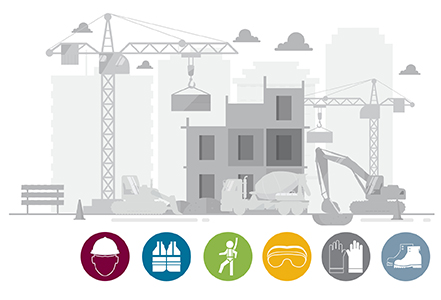In the United States construction industry, falls are the leading cause of worker injuries and fatalities. In 2018, 338 out of 1,008 total deaths in construction were from falls (33.5%), according to the US Bureau of Labor Statistics. The standard for fall protection deals with both the human and equipment-related issues in protecting workers from fall hazards.
The OSHA standard (29 CFR 1926.501(b))(1)) states: “Each employee on a walking/working surface (horizontal and vertical surface) with an unprotected side or edge which is 6 feet (1.8 m) or more above a lower level shall be protected from falling by the use of guardrail systems, safety net systems or personal fall arrest systems.”
The risk for falls is virtually present in every single workplace. However, the factors that can lead to a fall varies. There are specific unsafe acts by employees as well as unsafe conditions that can lead to fall incidents. Moreover, falls often result from a series of contributing factors. At times, they are the result of unsafe conditions and actions combined. It is important to look at both unsafe conditions as well as unsafe actions to recognize hazardous situations.

Unsafe Conditions that Lead to Falls
- Unguarded leading edges
- Open holes
- Improper guardrails
- Damaged equipment (ladders, stairs, safety equipment, etc.)
- Slippery conditions
- Unmarked elevation changes
Unsafe Actions that Lead to Falls
- Working at heights without fall protection or fall prevention methods like handrails
- Improper use of ladders
- Leaning over guardrails
Best Practices to Avoid Falls in the Workplace
A few safeguards can mitigate the risk of falling.
- Engineering controls such as physical barriers and guardrails are two fall protection systems that are effective in preventing falls from heights.
- Use approved and tagged scaffolding if a guardrail is not feasible.
- Use a proper fall arrest system such as a full body harness, self-retracting lanyard, and approved anchor point with 100% tie-off (required when working at heights 6ft or greater unless client policy is 4ft).
- Proper use of a ladder. This includes using three points of contact when climbing, not leaning to one side while on the ladder, setting the ladder at the proper angle, securing the ladder, etc.
- Proper housekeeping in work areas.
- Warning signs and other methods of communicating fall hazards to nearby workers.
- Inspect fall protection equipment before every use. Make this inspection a part of your daily safety checks prior to wearing.
- Never use equipment that is not rated or made for fall protection. Only approved fall protection equipment should be used. If you are unsure, stop and ask.